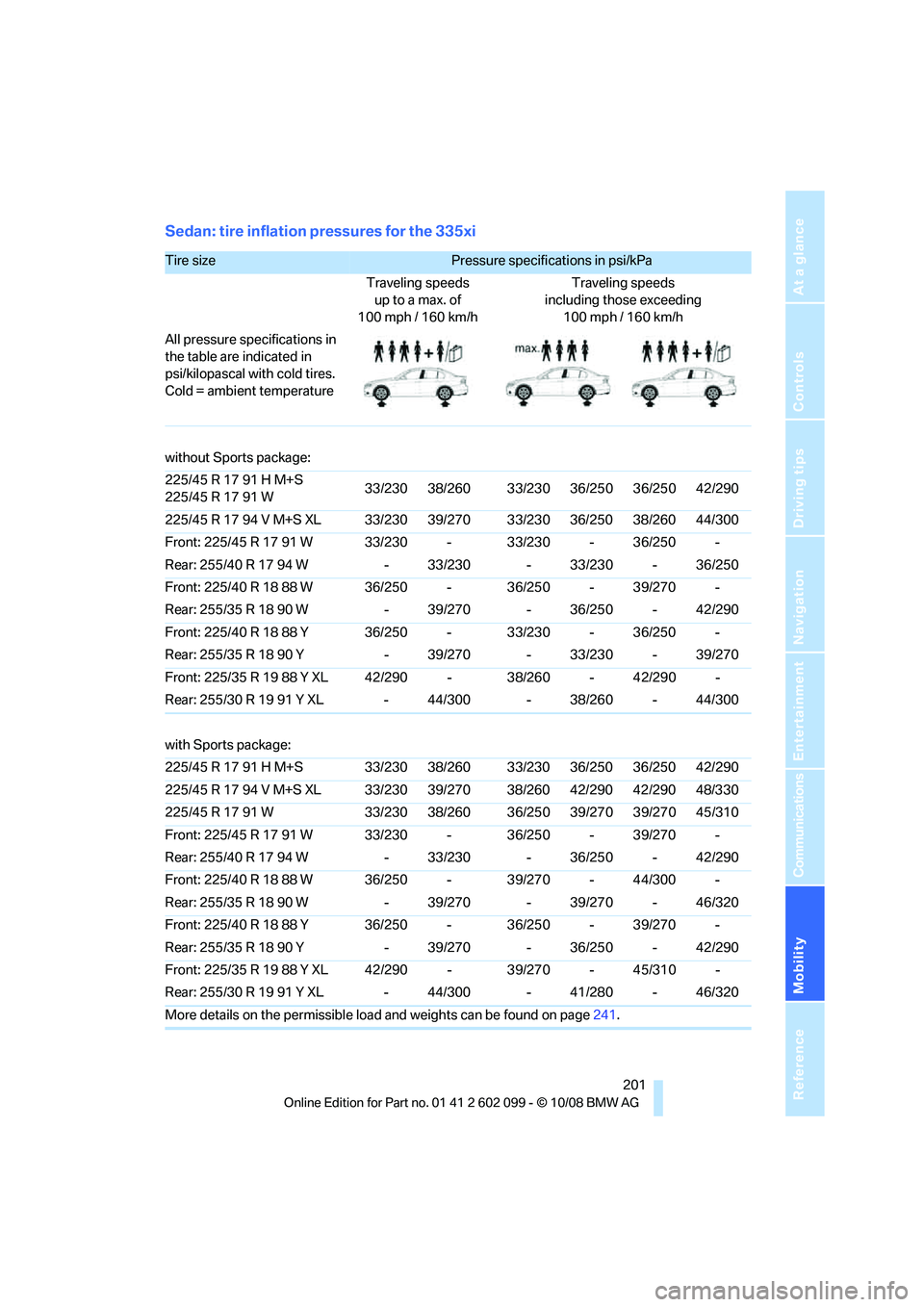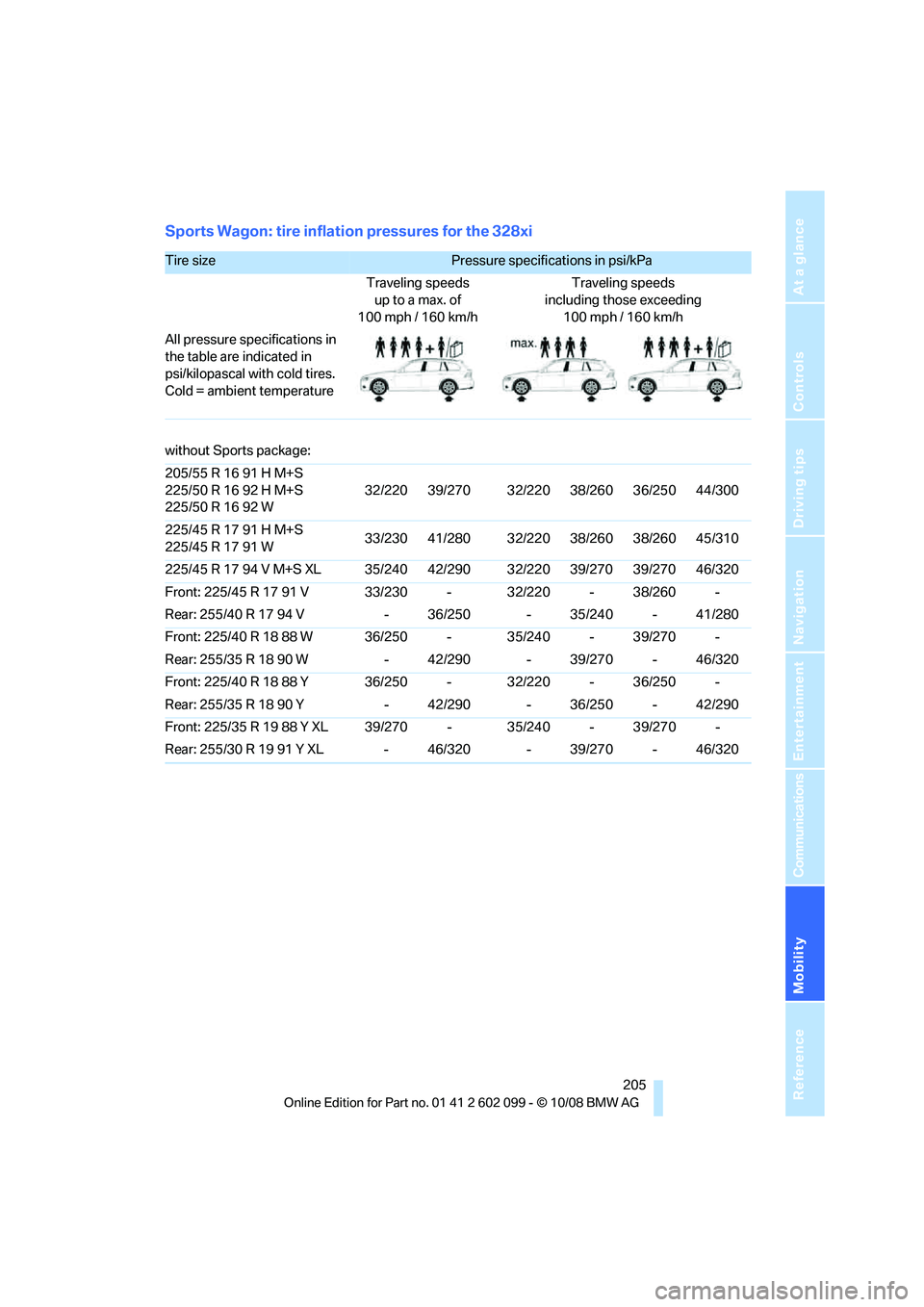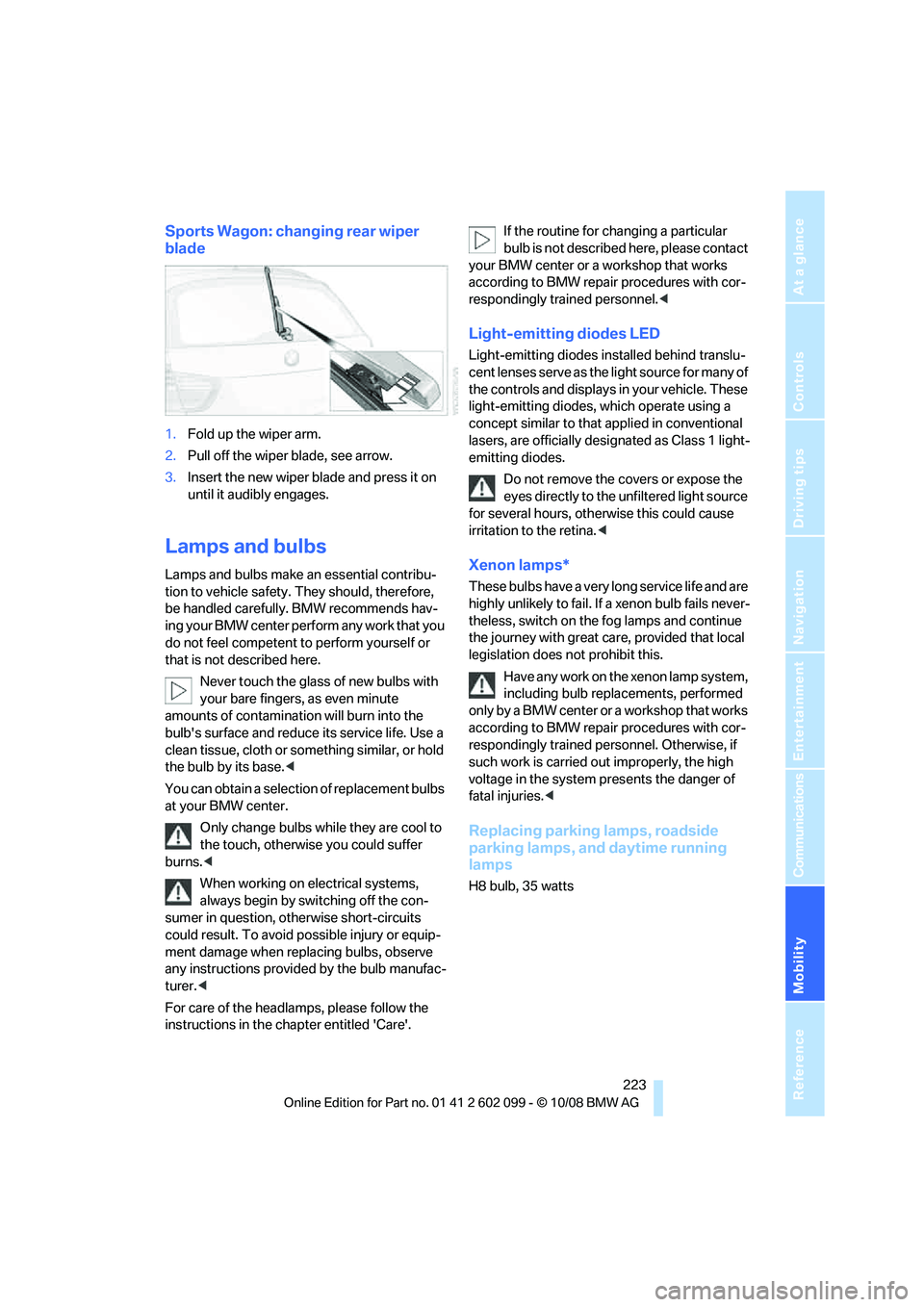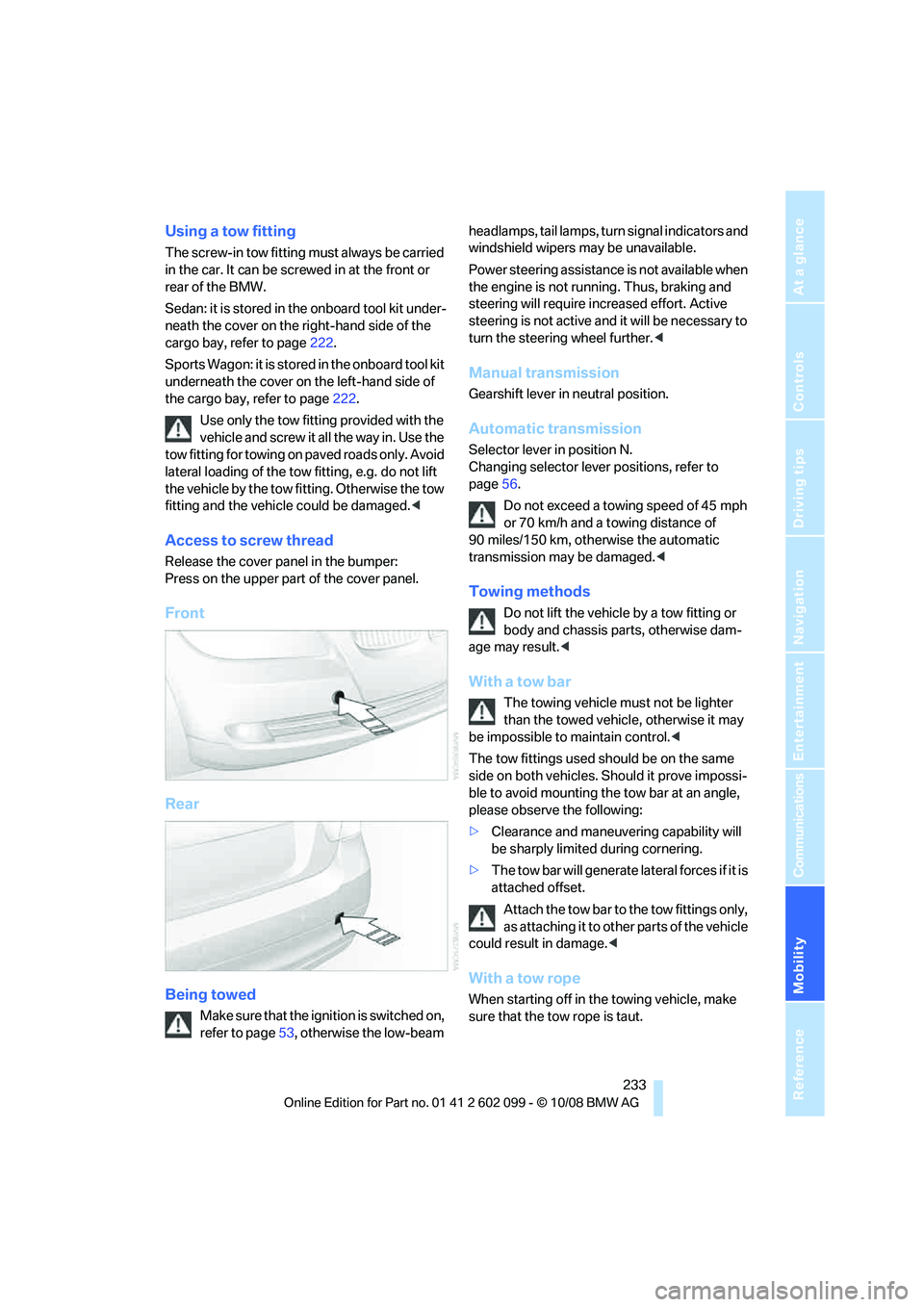2009 BMW 330D rear entertainment
[x] Cancel search: rear entertainmentPage 203 of 268

Mobility
201Reference
At a glance
Controls
Driving tips
Communications
Navigation
Entertainment
Sedan: tire inflation pressures for the 335xi
Tire size Pressure specifications in psi/kPa
Traveling speeds up to a max. of
100 mph / 160 km/h Traveling speeds
including those exceeding 100 mph / 160 km/h
All pressure specifications in
the table are indicated in
psi/kilopascal with cold tires.
Cold = ambient temperature
without Sports package:
225/45 R 17 91 H M+S
225/45 R 17 91 W 33/230 38/260 33/230 36/250 36/250 42/290
225/45 R 17 94 V M+S XL 33/230 39/270 33/230 36/250 38/260 44/300
Front: 225/45 R 17 91 W 33/230 - 33/230 - 36/250 -
Rear: 255/40 R 17 94 W - 33/230 - 33/230 - 36/250
Front: 225/40 R 18 88 W 36/250 - 36/250 - 39/270 -
Rear: 255/35 R 18 90 W - 39/270 - 36/250 - 42/290
Front: 225/40 R 18 88 Y 36/250 - 33/230 - 36/250 -
Rear: 255/35 R 18 90 Y - 39/270 - 33/230 - 39/270
Front: 225/35 R 19 88 Y XL 42/290 - 38/260 - 42/290 -
Rear: 255/30 R 19 91 Y XL - 44/300 - 38/260 - 44/300
with Sports package:
225/45 R 17 91 H M+S 33/230 38/260 33/230 36/250 36/250 42/290
225/45 R 17 94 V M+S XL 33/230 39/270 38/260 42/290 42/290 48/330
225/45 R 17 91 W 33/230 38/260 36/250 39/270 39/270 45/310
Front: 225/45 R 17 91 W 33/230 - 36/250 - 39/270 -
Rear: 255/40 R 17 94 W - 33/230 - 36/250 - 42/290
Front: 225/40 R 18 88 W 36/250 - 39/270 - 44/300 -
Rear: 255/35 R 18 90 W - 39/270 - 39/270 - 46/320
Front: 225/40 R 18 88 Y 36/250 - 36/250 - 39/270 -
Rear: 255/35 R 18 90 Y - 39/270 - 36/250 - 42/290
Front: 225/35 R 19 88 Y XL 42/290 - 39/270 - 45/310 -
Rear: 255/30 R 19 91 Y XL - 44/300 - 41/280 - 46/320
More details on the permissible load and weights can be found on page241.
ba8_E9091_cic.book Seite 201 Mittwoch, 29. Oktober 2008 2:59 14
Page 205 of 268

Mobility
203Reference
At a glance
Controls
Driving tips
Communications
Navigation
Entertainment
Sports Wagon: tire inflation pressures for the 328i
Tire size Pressure specifications in psi/kPa
Traveling speeds up to a max. of
100 mph / 160 km/h Traveling speeds
including those exceeding 100 mph / 160 km/h
All pressure specifications in
the table are indicated in
psi/kilopascal with cold tires.
Cold = ambient temperature
without Sports package:
225/50 R 16 92 H M+S
225/50 R 16 92 W 32/220 39/270 32/220 36/250 36/250 44/300
205/55 R 16 91 H M+S 32/220 39/270 32/220 39/270 39/270 46/320
225/45 R 17 91 H M+S
225/45 R 17 91 W 33/230 41/280 32/220 39/270 39/270 46/320
225/45 R 17 94 V M+S XL 35/240 42/290 33/230 41/280 41/280 48/330
Front: 225/45 R 17 91 V 33/230 - 32/220 - 39/270 -
Rear: 255/40 R 17 94 V - 36/250 - 35/240 - 42/290
Front: 225/40 R 18 88 W 36/250 - 32/220 - 39/270 -
Rear: 255/35 R 18 90 W - 44/300 - 39/270 - 46/320
Front: 225/40 R 18 88 Y 36/250 - 32/220 - 36/250 -
Rear: 255/35 R 18 90 Y - 44/300 - 36/250 - 44/300
Front: 225/35 R 19 88 Y XL 41/280 - 33/230 - 41/280 -
Rear: 255/30 R 19 91 Y XL - 48/330 - 41/280 - 48/330
ba8_E9091_cic.book Seite 203 Mittwoch, 29. Oktober 2008 2:59 14
Page 207 of 268

Mobility
205Reference
At a glance
Controls
Driving tips
Communications
Navigation
Entertainment
Sports Wagon: tire inflation pressures for the 328xi
Tire size Pressure specifications in psi/kPa
Traveling speeds up to a max. of
100 mph / 160 km/h Traveling speeds
including those exceeding 100 mph / 160 km/h
All pressure specifications in
the table are indicated in
psi/kilopascal with cold tires.
Cold = ambient temperature
without Sports package:
205/55 R 16 91 H M+S
225/50 R 16 92 H M+S
225/50 R 16 92 W 32/220 39/270 32/220 38/260 36/250 44/300
225/45 R 17 91 H M+S
225/45 R 17 91 W 33/230 41/280 32/220 38/260 38/260 45/310
225/45 R 17 94 V M+S XL 35/240 42/290 32/220 39/270 39/270 46/320
Front: 225/45 R 17 91 V 33/230 - 32/220 - 38/260 -
Rear: 255/40 R 17 94 V - 36/250 - 35/240 - 41/280
Front: 225/40 R 18 88 W 36/250 - 35/240 - 39/270 -
Rear: 255/35 R 18 90 W - 42/290 - 39/270 - 46/320
Front: 225/40 R 18 88 Y 36/250 - 32/220 - 36/250 -
Rear: 255/35 R 18 90 Y - 42/290 - 36/250 - 42/290
Front: 225/35 R 19 88 Y XL 39/270 - 35/240 - 39/270 -
Rear: 255/30 R 19 91 Y XL - 46/320 - 39/270 - 46/320
ba8_E9091_cic.book Seite 205 Mittwoch, 29. Oktober 2008 2:59 14
Page 221 of 268

Mobility
219Reference
At a glance
Controls
Driving tips
Communications
Navigation
Entertainment
eras, e.g. of the Park Distance Control or Rear
View Camera, for an extended period and main-
tain a distance of at least 12 in/30 cm.<
Manual car wash
When washing the vehicle by hand, use large
quantities of water and car shampoo if neces-
sary. Clean the vehicle with a sponge or wash-
ing brush, applying light pressure only.
Before cleaning the windshield, deacti-
vate the rain sensor or switch off the igni-
tion to prevent unintent ional activation of the
wipers. <
Observe local regulations pertaining to
washing vehicles by hand. <
Headlamps
Do not rub them dry and do not use abrasive or
corrosive cleaning agents.
Remove contamination, such as insects, by
soaking with shampoo or insect remover and
then rinsing with plenty of water.
Thaw ice with a windshield de-icer and do not
use an ice scraper.
Windows
Clean the inside and outside surfaces of the
windows and the mirrors with window cleaner.
Do not clean the mirrors with cleaners
containing quartz. <
Wiper blades
Clean with soapy water and replace regularly to
avoid streaking.
Wax and preservative residue and con-
tamination on the wi ndow can lead to
streaking when operating the windshield wip-
ers, leading to premature wear of the wiper
blades and causing the ra in sensor to malfunc-
tion. <
Paintwork care
Regular care contributes to value retention and
protects the paintwork against the long-term
effects of damaging substances. Region-specific environmental influences can
damage the vehicle paintwork. Therefore, it is
important to adapt the frequency and scope of
car care accordingly.
Immediately remove ve
ry aggressive sub-
stances, e.g. spilled fuel, oil, grease, tree resin
or bird droppings, to prevent damage to the
paintwork.
Repairing paintwork damage
Immediately repair scratches or similar
damage, such as that caused by stones
hitting the vehicle, wher e necessary to prevent
rusting. <
BMW recommends having paintwork damage
repaired by a profession al paint repair work-
shop according to BMW specifications using
original BMW paint materials.
Preservation
A preservation treatmen t is necessary when
water no longer beads off of the clean paintwork
surface. Only use products for paintwork pres-
ervation that contain carnauba or synthetic
waxes.
Rubber seals
Treat only with water or rubber care products.
Do not use silicon-containing care prod-
ucts on rubber seals, otherwise noise and
damage could occur. <
Chrome parts
Carefully clean vehicle parts, such as the radia-
tor grill, door handles or window frames, with
copious quantities of water and a shampoo
additive. For additional treatment, use a chrome
polish.
Light-alloy wheels
For technical reasons, du st is generated during
braking that is deposi ted on the light-alloy
wheels. Remove the dust regularly using acid-
free rim cleaner.
Do not use aggressive, acidic, strongly
alkaline and abrasive cleaning agents or
ba8_E9091_cic.book Seite 219 Mittwoch, 29. Oktober 2008 2:59 14
Page 225 of 268

Mobility
223Reference
At a glance
Controls
Driving tips
Communications
Navigation
Entertainment
Sports Wagon: changing rear wiper
blade
1.Fold up the wiper arm.
2. Pull off the wiper blade, see arrow.
3. Insert the new wiper blade and press it on
until it audibly engages.
Lamps and bulbs
Lamps and bulbs make an essential contribu-
tion to vehicle safety. They should, therefore,
be handled carefully. BMW recommends hav-
ing your BMW center perf orm any work that you
do not feel competent to perform yourself or
that is not described here.
Never touch the glass of new bulbs with
your bare fingers, as even minute
amounts of contamination will burn into the
bulb's surface and reduce its service life. Use a
clean tissue, cloth or some thing similar, or hold
the bulb by its base. <
You can obtain a selectio n of replacement bulbs
at your BMW center.
Only change bulbs while they are cool to
the touch, otherwise you could suffer
burns. <
When working on electrical systems,
always begin by switching off the con-
sumer in question, otherwise short-circuits
could result. To avoid po ssible injury or equip-
ment damage when replacing bulbs, observe
any instructions provided by the bulb manufac-
turer. <
For care of the headlamps, please follow the
instructions in the chapter entitled 'Care'. If the routine for changing a particular
bulb is not described here, please contact
your BMW center or a workshop that works
according to BMW repair procedures with cor-
respondingly trained personnel. <
Light-emitting diodes LED
Light-emitting diodes installed behind translu-
c e n t l e n s e s s e r v e a s t h e l i g h t s o u r c e f o r m a n y o f
the controls and displays in your vehicle. These
light-emitting diodes, which operate using a
concept similar to that applied in conventional
lasers, are officially desi gnated as Class 1 light-
emitting diodes.
Do not remove the co vers or expose the
eyes directly to the un filtered light source
for several hours, otherwise this could cause
irritation to the retina. <
Xenon lamps*
These bulbs have a very long service life and are
highly unlikely to fail. If a xenon bulb fails never-
theless, switch on the fog lamps and continue
the journey with great ca re, provided that local
legislation does not prohibit this.
Have any work on the xenon lamp system,
including bulb replacements, performed
only by a BMW center or a workshop that works
according to BMW repair procedures with cor-
respondingly trained pers onnel. Otherwise, if
such work is carried out improperly, the high
voltage in the system presents the danger of
fatal injuries. <
Replacing parking lamps, roadside
parking lamps, and daytime running
lamps
H8 bulb, 35 watts
ba8_E9091_cic.book Seite 223 Mittwoch, 29. Oktober 2008 2:59 14
Page 231 of 268

Mobility
229Reference
At a glance
Controls
Driving tips
Communications
Navigation
Entertainment
Charging the battery
Only charge the battery in the vehicle via the
terminals in the engine compartment with the
engine off. Connections, refer to Jump starting
on page 231.
Disposal
Have old batteries disposed of by your
BMW center or hand them in to a recy-
cling center. Maintain the battery in an upright
position for transport and storage. Always
secure the battery agains t tipping over during
transport.<
Power failure
After a temporary power loss, the functioning of
some equipment may be limited and require
reinitialization. Individual settings may likewise
have been lost and will have to be programmed:
> Time and date
These values must be updated, refer to
page 73.
> Radio
In some cases, stations may have to be
stored again, refer to page 145.
> Navigation system
Operability must be waited for, refer to
page 122.
> Glass roof
It may happen that the roof can only be
raised. The system must be initialized.
Please contact your BMW center.
> Panorama glass roof
It may happen that the roof can only be
raised. The system must be initialized.
Please contact your BMW center.
> Seat and mirror memory
The positions must be stored again, refer to
page 45.
> Inside rearview mirror with digital compass
The system must be calibrated, refer to
page 101.
Fuses
Never attempt to repa ir a blown fuse and
do not replace a defective fuse with a sub-
stitute of another color or amperage rating, oth-
erwise this could lead to a circuit overload, ulti-
mately resulting in a fire in the vehicle.<
Open the cover in the glove compartment and
remove it.
Spare fuses and a pair of plastic forceps are set
in holders on the distributor box.
See the rear of the cover for information on fuse
assignment.
ba8_E9091_cic.book Seite 229 Mittwoch, 29. Oktober 2008 2:59 14
Page 235 of 268

Mobility
233Reference
At a glance
Controls
Driving tips
Communications
Navigation
Entertainment
Using a tow fitting
The screw-in tow fitting must always be carried
in the car. It can be screwed in at the front or
rear of the BMW.
Sedan: it is stored in the onboard tool kit under-
neath the cover on the right-hand side of the
cargo bay, refer to page 222.
Sports Wagon: it is stored in the onboard tool kit
underneath the cover on the left-hand side of
the cargo bay, refer to page 222.
Use only the tow fitting provided with the
vehicle and screw it all the way in. Use the
tow fitting for towing on paved roads only. Avoid
lateral loading of the tow fitting, e.g. do not lift
the vehicle by the tow fi tting. Otherwise the tow
fitting and the vehicle could be damaged. <
Access to screw thread
Release the cover panel in the bumper:
Press on the upper part of the cover panel.
Front
Rear
Being towed
Make sure that the ignition is switched on,
refer to page53, otherwise the low-beam headlamps, tail lamps, turn
signal indicators and
windshield wipers may be unavailable.
Power steering assistance is not available when
the engine is not running. Thus, braking and
steering will require increased effort. Active
steering is not active an d it will be necessary to
turn the steering wheel further.<
Manual transmission
Gearshift lever in neutral position.
Automatic transmission
Selector lever in position N.
Changing selector lever positions, refer to
page56.
Do not exceed a towing speed of 45 mph
or 70 km/h and a towing distance of
90 miles/150 km, otherwise the automatic
transmission may be damaged. <
Towing methods
Do not lift the vehicle by a tow fitting or
body and chassis parts, otherwise dam-
age may result. <
With a tow bar
The towing vehicle must not be lighter
than the towed vehicl e, otherwise it may
be impossible to maintain control.<
The tow fittings used should be on the same
side on both vehicles. Should it prove impossi-
ble to avoid mounting the tow bar at an angle,
please observe the following:
> Clearance and maneuvering capability will
be sharply limited during cornering.
> The tow bar will generate la teral forces if it is
attached offset.
Attach the tow bar to the tow fittings only,
as attaching it to other parts of the vehicle
could result in damage. <
With a tow rope
When starting off in the towing vehicle, make
sure that the tow rope is taut.
ba8_E9091_cic.book Seite 233 Mittwoch, 29. Oktober 2008 2:59 14
Page 243 of 268

Reference 241
At a glance
Controls
Driving tips
Communications
Navigation
Entertainment
Mobility
Weights
Sedan
Never exceed either the approved axle loads or
the gross vehicle weight.
323i
(Canada)328i328i
xDrive
Approved gross weight
> with manual transmission lbs/kg 4,365/1,980 4,420/2,005 4,663/2,115
> with automatic transmission lb s/kg 4,431/2,010 4,486/2,035 4,707/2,135
Load lbs/kg 1,014/460 1,014/460 1,014/460
Approved front axle load lb s/kg 2,105/955 2,127/965 2,304/1,045
Approved rear axle load lbs/ kg 2,425/1,100 2,469/1,120 2,513/1,140
Approved roof load capacity lbs/kg 165/75165/75 165/75
Cargo bay capacity cu ft/l 16.2/460 16.2/460 16.2/460
335i335i
xDrive335d
Approved gross weight
> with manual transmission lbs/kg 4,652/2,110 4,872/2,210 -
> with automatic transmission lb s/kg 4,663/2,115 4,883/2,215 4,883/2,215
Load lbs/kg 1,014/460 1,014/460 1,014/460
Approved front axle load lb s/kg 2,238/1,015 2,436/1,105 2,381/1,080
Approved rear axle load lbs/ kg 2,546/1,155 2,546/1,155 2,646/1,200
Approved roof load capacity lbs/kg 165/75165/75 165/75
Cargo bay capacity cu ft/l 15.9/450 15.9/450 15.9/450
ba8_E9091_cic.book Seite 241 Mittwoch, 29. Oktober 2008 2:59 14